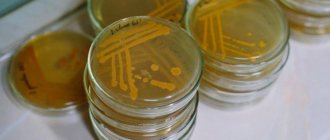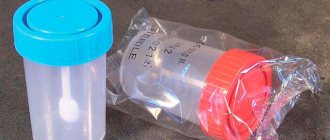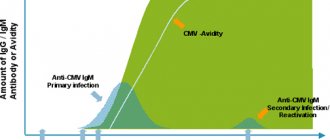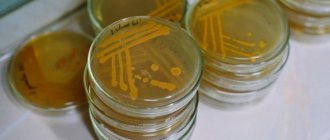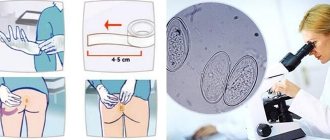How to properly collect stool for analysis
Different laboratories may use different research methods and units of measurement. In order for the assessment of the examination results to be correct and the results to be acceptable, it is advisable to conduct research in the same laboratory at the same time.
Rules for collecting stool for research
intestinal microflora (dysbacteriosis)
General requirements:
Use only disposable containers provided by the laboratory. The container is sterile, does not require pre-treatment and is completely ready for use. Feces should be collected in the morning - after natural bowel movements. Sample preparation in advance is not permitted. Freezing or storing the sample in the refrigerator is not permitted. All examined patients, 1-3 days before taking the sample, should be on a diet that excludes the intake of foods that enhance fermentation processes in the intestines and lactic acid products, as well as alcohol and bacterial preparations (containing bifidobacteria, lactobacilli, E. coli). Conducting research and collecting material before starting treatment with antibiotics, antiseptics, antifungal drugs or no earlier than 2-3 weeks after the end of the course of treatment.
What you should definitely do:
Thorough toileting of the external genitalia and anal area. Pre-urinate. It is not recommended to collect feces from the toilet. Defecate in a dry, clean container - a vessel or a “night vase”. First you need to rinse well with soap and a sponge, rinse repeatedly with tap water, and then rinse with boiling water and cool. It is not permissible to treat the vessel with synthetic detergents. Transfer the stool sample with a special spoon mounted into the lid of a sterile container in an amount of no more than 1/3 of the container’s volume. Close the lid carefully. The following must not be allowed:
You cannot conduct a stool examination earlier than 2 days after an enema, an X-ray examination of the stomach and intestines, or a colonoscopy. All examined patients, 1-3 days before taking the sample, should be on a diet that excludes the intake of foods that enhance fermentation processes in the intestines and lactic acid products, as well as alcohol and bacterial preparations (containing bifidobacteria, lactobacilli, E. coli). On the eve of the study, you should not take medications, including: laxatives; Activated carbon; preparations of iron, copper, bismuth; use fat-based rectal suppositories. Do not allow urine or water into the sample. Conduct stool examinations in women during menstruation.
Failure to comply with the rules for collecting, timing and storage of samples obtained for research leads to a negative result.
Enterobiasis test
For self-collection, the procedure is carried out in the morning immediately after getting out of bed before performing hygiene procedures, urination and defecation. Using a cotton swab, the material is taken from the perianal folds in a circular motion, after which the swab is placed in a special test tube. The material is delivered to the laboratory on the day of collection of the material.
Analysis of stool for coprogram
No special preparation is required. When diagnosing certain diseases, a doctor may prescribe a special diet for several days. 3-4 days before the study, stop taking laxatives, castor and vaseline oil and stop administering rectal suppositories. Also, a few days before the examination, it is necessary to avoid taking iron and bismuth supplements. It is unacceptable to send feces for examination in matchboxes or cardboard boxes, as this changes the shape and consistency of the feces and distorts the results of the analysis. Disposable plastic containers must be used.
Fecal occult blood test
For 3-4 days before collecting the analysis, it is necessary to exclude meat (liver, beef, lamb), some vegetables (cucumbers, melon, cauliflower, radishes, horseradish, turnips, broccoli, bell peppers, spinach, apples, beans) from the diet. . Also during this period, exclude excess amounts of vitamin C (no more than 250 mg per day), both in the form of preparations and in food products (citrus fruits and juices), and iron supplements. Within 7 days before the analysis, it is necessary to stop taking aspirin and non-steroidal anti-inflammatory drugs (diclofenac, voltaren, movalis, etc.), and alcoholic beverages are also excluded. The test is not taken during menstruation. The stool should be obtained without the use of enemas or laxatives.
Take tests constantly in the same laboratory - and your doctor will approximately know your personal normal values and any deviation from the norm will be immediately noticed by him.
Home visit Addresses of medical offices Frequently asked questions Personal data processing policy
Coprogram: senseless and merciless
Coprogram (general stool analysis) is one of the most common tests in a domestic children's clinic or hospital. If you open the medical history of a patient with ARVI, tonsillitis, or even a traumatic brain injury, there, along with a clinical analysis of blood and urine, you will definitely find a coprogram. Most doctors have become so accustomed to this since Soviet times that the question does not even occur to them: why, in fact, stool microscopy in the treatment of otitis media or pneumonia?
We sometimes see the same picture in outpatient settings. Let’s say the child is healthy, gaining weight well, and has normal stools—it seems, what else is needed for happiness? Of course, it is a coprogram, which pediatricians must prescribe to all healthy infants at least twice, without any indication.
According to the “protocol,” the coprogram is the most important diagnostically significant analysis and is used to diagnose various diseases of the gastrointestinal tract (GIT).
Coprogram
A coprogram is a study of feces (feces, excrement, stool), an analysis of its physical and chemical properties, as well as various components and inclusions of various origins. It is part of a diagnostic study of the digestive organs and the function of the gastrointestinal tract.
Synonyms Russian
General stool analysis.
English synonyms
Koprogramma, Tool analysis.
Research method
Microscopy.
What biomaterial can be used for research?
Cal.
How to properly prepare for research?
Avoid taking laxatives, administering rectal suppositories, oils, limit taking medications that affect intestinal motility (belladonna, pilocarpine, etc.) and the color of stool (iron, bismuth, barium sulfate) for 72 hours before donating stool.
General information about the study
A coprogram is a study of feces (feces, excrement, stool), an analysis of its physical and chemical properties, as well as various components and inclusions of various origins. It is part of a diagnostic study of the digestive organs and the function of the gastrointestinal tract.
Feces are the final product of food digestion in the gastrointestinal tract under the influence of digestive enzymes, bile, gastric juice and the activity of intestinal bacteria.
The composition of feces is water, the content of which is normally 70-80%, and a dry residue. In turn, the dry residue consists of 50% living bacteria and 50% from the remains of digested food. Even within normal limits, the composition of stool is largely variable. It largely depends on nutrition and fluid intake. The composition of feces varies even more in various diseases. The amount of certain components in the stool changes with pathology or dysfunction of the digestive organs, although deviations in the functioning of other body systems can also significantly affect the activity of the gastrointestinal tract, and therefore the composition of stool. The nature of changes in various types of diseases is extremely diverse. The following groups of violations of the composition of feces can be distinguished:
- change in the amount of components that are normally contained in stool,
- undigested and/or undigested food remains,
- biological elements and substances secreted from the body into the intestinal lumen,
- various substances that are formed in the intestinal lumen from metabolic products, tissues and cells of the body,
- microorganisms,
- foreign inclusions of biological and other origin.
What is the research used for?
- For the diagnosis of various diseases of the gastrointestinal tract: pathologies of the liver, stomach, pancreas, duodenum, small and large intestine, gall bladder and biliary tract.
- To evaluate the results of treatment of diseases of the gastrointestinal tract requiring long-term medical supervision.
When is the study scheduled?
- For symptoms of any disease of the digestive system: pain in various parts of the abdomen, nausea, vomiting, diarrhea or constipation, changes in the color of feces, blood in stool, loss of appetite, loss of body weight despite satisfactory nutrition, deterioration in the condition of skin, hair and nails, yellowness of the skin and/or whites of the eyes, increased gas formation.
- When the nature of the disease requires monitoring the results of its treatment during therapy.
What do the results mean?
Reference values
| Index | Reference values |
| Consistency | Dense, shaped, hard, soft |
| Form | Shaped, cylindrical |
| Smell | Fecal, sour |
| Color | Light brown, brown, dark brown, yellow, yellow-green, olive |
| Reaction | Neutral, weakly acidic |
| Blood | No |
| Slime | None, small quantity |
| Leftover undigested food | None |
| Muscle fibers are changed | Large, moderate, small amount, none |
| Muscle fibers unchanged | None |
| Detritus | Absent, small, moderate, large amount |
| Digestible plant fiber | None, small quantity |
| Fat neutral | Absent |
| Fatty acid | None, small quantity |
| Soap | None, small quantity |
| Intracellular starch | Absent |
| Extracellular starch | None |
| Red blood cells | 0 — 1 |
| Crystals | No, cholesterol, activated carbon |
| Iodophilic flora | Absent |
| Clostridia | None, small quantity |
| Yeast-like fungi | None |
Consistency/shape
The consistency of the stool is determined by the percentage of water it contains. The normal water content in feces is 75%. In this case, the stool has a moderately dense consistency and a cylindrical shape, i.e., stool is formed. Eating an increased amount of plant foods containing a lot of fiber leads to increased intestinal motility, and the feces become mushy. A thinner, watery consistency is associated with an increase in water content to 85% or more.
Liquid, mushy stool is called diarrhea. In many cases, stool liquefaction is accompanied by an increase in the quantity and frequency of bowel movements during the day. According to the mechanism of development, diarrhea is divided into those caused by substances that interfere with the absorption of water from the intestine (osmotic), resulting from increased secretion of fluid from the intestinal wall (secretory), resulting from increased intestinal peristalsis (motor) and mixed.
Osmotic diarrhea often occurs as a result of impaired breakdown and absorption of food elements (fats, proteins, carbohydrates). Occasionally, this can occur when consuming certain indigestible osmotically active substances (magnesium sulfate, salt water). Secretory diarrhea is a sign of inflammation of the intestinal wall of infectious and other origins. Motor diarrhea can be caused by certain medications and dysfunction of the nervous system. Often the development of a particular disease is associated with the involvement of at least two mechanisms of diarrhea; such diarrhea is called mixed.
Hard stool occurs when the movement of stool through the large intestine slows down, which is accompanied by excessive dehydration (water content in stool is less than 50-60%).
Smell
The usual mild smell of feces is associated with the formation of volatile substances that are synthesized as a result of bacterial fermentation of protein elements in food (indole, skatole, phenol, cresols, etc.). This odor intensifies with excessive consumption of protein foods or insufficient consumption of plant foods.
The sharp foul odor of feces is due to increased putrefactive processes in the intestines. A sour smell occurs with increased fermentation of food, which may be associated with a deterioration in the enzymatic breakdown of carbohydrates or their absorption, as well as with infectious processes.
Color
The normal color of stool is due to the presence of stercobilin, the end product of bilirubin metabolism, which is released into the intestines with bile. In turn, bilirubin is a breakdown product of hemoglobin, the main functional substance of red blood cells (hemoglobin). Thus, the presence of stercobilin in feces is the result, on the one hand, of the functioning of the liver, and on the other, the constant process of updating the cellular composition of the blood. The color of stool normally varies depending on the composition of the food. Darker stool is associated with the consumption of meat foods, while a dairy-vegetable diet leads to lighter stools.
Discolored feces (acholic) is a sign of the absence of stercobilin in the stool, which can be caused by the fact that bile does not enter the intestines due to blockage of the biliary tract or a sharp violation of the biliary function of the liver.
Very dark Kalinogda is a sign of increased concentration of stercobilin in the stool. In some cases, this is observed with excessive breakdown of red blood cells, which causes increased excretion of hemoglobin metabolic products.
Red flowers may be caused by bleeding from the lower intestines.
Black color is a sign of bleeding from the upper gastrointestinal tract. In this case, the black color of the stool is a consequence of the oxidation of hemoglobin in the blood by hydrochloric acid of the gastric juice.
Reaction
The reaction reflects the acid-base properties of the stool. An acidic or alkaline reaction in feces is due to the increased activity of certain types of bacteria, which occurs when food fermentation is disrupted. Normally, the reaction is neutral or slightly alkaline. Alkaline properties increase with the deterioration of enzymatic breakdown of proteins, which accelerates their bacterial decomposition and leads to the formation of ammonia, which has an alkaline reaction.
The acid reaction is caused by the activation of bacterial decomposition of carbohydrates in the intestines (fermentation).
Blood
Blood in the stool occurs when there is bleeding in the gastrointestinal tract.
Slime
Mucus is a secretion product of cells lining the inner surface of the intestine (intestinal epithelium). The function of mucus is to protect intestinal cells from damage. Normally, there may be some mucus in the stool. During inflammatory processes in the intestines, mucus production increases and, accordingly, its amount in the feces increases.
Detritus
Detritus is small particles of digested food and destroyed bacterial cells. Bacterial cells can be destroyed by inflammation.
Leftover undigested food
Residues of food in the stool can appear when there is insufficient production of gastric juice and/or digestive enzymes, as well as when intestinal motility accelerates.
Muscle fibers are changed
Changed muscle fibers are a product of digestion of meat foods. An increase in the content of slightly altered muscle fibers in feces occurs when the conditions for protein breakdown worsen. This may be caused by insufficient production of gastric juice and digestive enzymes.
Muscle fibers unchanged
Unchanged muscle fibers are elements of undigested meat food. Their presence in the stool is a sign of impaired protein breakdown (due to impaired secretory function of the stomach, pancreas or intestines) or accelerated movement of food through the gastrointestinal tract.
Digestible plant fiber
Digestible plant fiber is the cells of the pulp of fruits and other plant foods. It appears in feces when digestive conditions are violated: secretory insufficiency of the stomach, increased putrefactive processes in the intestines, insufficient secretion of bile, digestive disorders in the small intestine.
Fat neutral
Neutral fat is the fatty components of food that have not been broken down and absorbed and are therefore excreted from the intestines unchanged. For normal fat breakdown, pancreatic enzymes and a sufficient amount of bile are necessary, the function of which is to separate the fat mass into a fine-droplet solution (emulsion) and repeatedly increase the area of contact of fat particles with molecules of specific enzymes - lipases. Thus, the appearance of neutral fat in the stool is a sign of insufficiency of the pancreas, liver, or a violation of the secretion of bile into the intestinal lumen.
In children, a small amount of fat in the stool may be normal. This is due to the fact that their digestive organs are not yet sufficiently developed and therefore do not always cope with the load of assimilation of adult food.
Fatty acid
Fatty acids are products of the breakdown of fats by digestive enzymes - lipases. The appearance of fatty acids in the stool is a sign of a violation of their absorption in the intestines. This may be caused by a violation of the absorption function of the intestinal wall (as a result of the inflammatory process) and/or increased peristalsis.
Soap
Soaps are modified remains of undigested fats. Normally, 90-98% of fats are absorbed during the digestion process; the remainder can bind with calcium and magnesium salts contained in drinking water and form insoluble particles. An increase in the amount of soap in the stool is a sign of impaired fat breakdown as a result of a lack of digestive enzymes and bile.
Intracellular starch
Intracellular starch is starch contained within the membranes of plant cells. It should not be detected in feces, since during normal digestion the thin cell membranes are destroyed by digestive enzymes, after which their contents are broken down and absorbed. The appearance of intracellular starch in feces is a sign of digestive disorders in the stomach as a result of a decrease in the secretion of gastric juice, digestive disorders in the intestines in the event of increased putrefactive or fermentative processes.
Extracellular starch
Extracellular starch is undigested starch grains from destroyed plant cells. Normally, starch is completely broken down by digestive enzymes and absorbed during the passage of food through the gastrointestinal tract, so it is not present in feces. Its appearance in the stool indicates insufficient activity of specific enzymes that are responsible for its breakdown (amylase) or too rapid movement of food through the intestines.
Leukocytes
Leukocytes are blood cells that protect the body from infections. They accumulate in the tissues of the body and its cavities, where the inflammatory process occurs. A large number of leukocytes in the stool indicates inflammation in various parts of the intestine caused by the development of infection or other reasons.
Red blood cells
Erythrocytes are red blood cells. The number of red blood cells in the stool may increase as a result of bleeding from the wall of the colon or rectum.
Crystals
Crystals are formed from various chemicals that appear in feces as a result of digestive disorders or various diseases. These include:
- tripelphosphates - are formed in the intestines in a sharply alkaline environment, which may be the result of the activity of putrefactive bacteria,
- hematoidin is a product of the transformation of hemoglobin, a sign of blood secretion from the wall of the small intestine,
- Charcot-Leiden crystals are a product of crystallization of the protein of eosinophils - blood cells that take an active part in various allergic processes; they are a sign of an allergic process in the intestines, which can be caused by intestinal helminths.
Iodophilic flora
Iodophilic flora is a collection of different types of bacteria that cause fermentation processes in the intestines. During laboratory testing, they can be stained with iodine solution. The appearance of iodophilic flora in the stool is a sign of fermentative dyspepsia.
Clostridia
Clostridia is a type of bacteria that can cause rot in the intestines. An increase in the number of clostridia in the stool indicates increased putrefaction of protein substances in the intestines due to insufficient fermentation of food in the stomach or intestines.
Epithelium
Epithelium is the cells of the inner lining of the intestinal wall. The appearance of a large number of epithelial cells in the stool is a sign of an inflammatory process in the intestinal wall.
Yeast-like fungi
Yeast-like fungi are a type of infection that develops in the intestines when there is insufficient activity of normal intestinal bacteria that prevent its occurrence. Their active reproduction in the intestines may be the result of the death of normal intestinal bacteria due to treatment with antibiotics or certain other drugs. In addition, the appearance of a fungal infection in the intestines is sometimes a sign of a sharp decrease in immunity.
Also recommended
- Fecal occult blood test
- Fecal analysis for helminth eggs
- Analysis of stool for cysts and vegetative forms of protozoa
- Enterobiasis
Who orders the study?
General practitioner, internist, gastroenterologist, surgeon, pediatrician, neonatologist, infectious disease specialist.
Literature
- Chernecky CC, Berger BJ (2008). Laboratory Tests and Diagnostic Procedures, 5th edition. St. Louis: Saunders.
- Fischbach FT, Dunning MB III, eds. (2009). Manual of Laboratory and Diagnostic Tests, 5th edition. Philadelphia: Lippincott Williams and Wilkins.
- Pagana KD, Pagana TJ (2010). Mosby's Manual of Diagnostic and Laboratory Tests, 4th edition. St. Louis: Mosby Elsevier.
